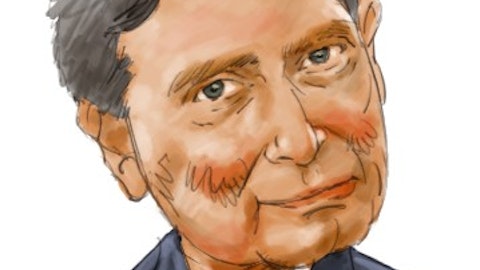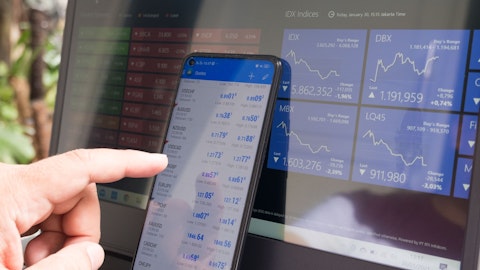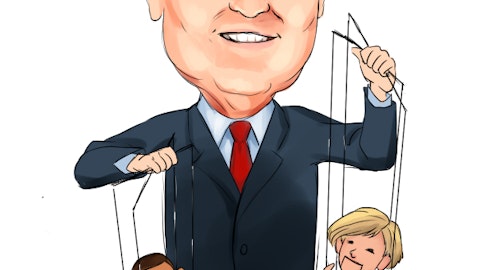DoorDash, Inc. (NASDAQ:DASH) Q4 2023 Earnings Call Transcript February 15, 2024
DoorDash, Inc. misses on earnings expectations. Reported EPS is $-0.39 EPS, expectations were $-0.15. DoorDash, Inc. isn’t one of the 30 most popular stocks among hedge funds at the end of the third quarter (see the details here).
Operator: Thank you for standing by. And welcome to the DoorDash Q4 2023 Earnings Call. I would now like to welcome Andrew Hargreaves, VP of Investor Relations to begin the call. Andy, over to you.
Andrew Hargreaves : Thanks, Mandy. Good afternoon, everybody, and thanks for joining us on our Q4 2023 earnings call. I’m very pleased today to be joined by Co-Founder Chair and CEO, Tony Xu; and CFO, Ravi Inukonda. We’ll be making forward-looking statements during today’s call, including our expectations for our business financial position, operating performance, our guidance, strategies, capital allocation approach and the broader economic environment. Forward-looking statements are subject to risks and uncertainties that could cause actual results to differ materially from those described. Many of these uncertainties are described in our SEC filings, including Form 10-Ks and 10-Qs. You should not rely on our forward-looking statements as predictions of future events.

We disclaim any obligation to update any forward-looking statements, except as required by law. During this call, we will discuss certain non-GAAP financial measures. Information regarding our non-GAAP financial measures, including a reconciliation to the most directly comparable GAAP financial measures may be found in our earnings release, which is available on our IR website. These non-GAAP measures should not — should be considered in addition to our GAAP results and are not intended to be a substitute for our GAAP results. Finally, this call is being audio webcasted on our IR website. An audio replay of the call will be available on our website shortly after the call ends. Mandy, we’ll pass it back to you, and we can take our first question.
Operator: The floor is now open for questions. [Operator Instructions] Our first question comes from the line of Michael Morton with Moffett Nathanson. Please go ahead.
See also 20 Cities With The Highest Cost of Living in the US and 10 Exclusive Dating Sites and Apps for Professionals.
Q&A Session
Follow Doordash Inc. (NYSE:DASH)
Follow Doordash Inc. (NYSE:DASH)
Michael Morton : Hi, good evening. Thanks for the question. First one for Tony. And then a second one for Ravi. Tony, I would love to hear your thoughts on what you think the future structure of the grocery market looks like. As order density increases on a store level, some industry participants think you might see more growth in the merchant picked model and also like consumers demand more speed. That kind of plays to your advantage with the Dashers. Would love to see how you see that evolving? And then for Ravi, we get a lot of investor questions on the ability to leverage sales and marketing on a per order basis. It seems like it might have slowed down just a tad in the fourth quarter and then looking at the forward guide. Could you talk a little bit about the opportunity to continue to leverage sales and marketing? Thank you.
Tony Xu : Hey, Michael, it’s Tony. Regarding your question on grocery, I think it really depends on what it is that you’re trying to build in terms of for the customer. I mean if you think about it, a customer is going to evaluate across several dimensions. They’re going to evaluate what grocers they can order from how good the order quality is in terms of if they order ex items, do they get exactly of those ex items, the affordability of the service and obviously, what happens with customer support, especially if things don’t go perfectly. And so we’re always judged on those dimensions, and we’re always building initiatives towards that. And a lot of this is still really nascent. If you think about DoorDash’s entry into the grocery space, which happened about three years ago, we really started by nailing this top-up use case, where we’re solving the middle of the week run and delivering the items that are consumed the most often, your berries, your dairy products, your cereals, your coffee, et cetera.
All of that was done in concert with fantastic grocers. We’re now shifting a lot of the work towards solving bigger baskets. And so that is just solving for a different use case for the consumer. And I think we’re also going to have to do other things, too, because when I just look at the structure of grocery, most of the behavior for consumers still happens off-line where consumers are purchasing groceries inside physical stores. And so that tells me that we still have — as an industry, a long ways to go to getting a product good enough such that it can replace the offline experience. All of this is going to be done in concert with grocers. And again, it’s this kind of continuum of where we want to make sure that we can solve for more than just one dimension.
Speed is one of those things, but there’s going to be other factors that we have to get right as well.
Ravi Inukonda : Hey, Michael, on the second point on sales and marketing, right? I’ll break it into two parts. First, we’ll talk about the Q3 to Q4 and then talk about the forward looking, what we expect in 2024. Q3 to Q4, we did generate leverage on consumer acquisition. The change that you’re seeing is largely related to Dasher acquisition. That was purely to support the higher growth that we saw in as well as, as you know, there’s some seasonal effect from a Dasher acquisition cost in Q4 in order for us to be able to continue to supply to the volumes that we had in Q4. As I look at it, right, when I think about overall leverage from a sales and marketing perspective, two frameworks here. One is we are trying to maximize sort of like payback periods, and our goal is to continue to be within the payback period.
You’re not looking at the absolute level of dollar investment. We’re still within the payback periods on the consumer side. We are still acquiring a healthy level of consumers. Over half of the new consumers in the U.S. today start their journey with DoorDash. So that’s going to be a continued way for us to continue to drive growth. On the second one, when I think about overall leverage, it purely starts from product. What you’ve done — we’ve done in the last year or so is we’ve continued to drive improvements in the product, whether it’s on the dasher side or the consumer side that ultimately improves retention. As the retention goes up, you’ll start to see benefits from an overall sales and marketing perspective also. So when I look at 2024, we do expect to generate leverage from an overall sales and marketing.
Michael Morton : Thank you.
Operator: Our next question comes from the line of Nikhil Devani with Bernstein. Please go ahead.
Nikhil Devani: Hi, there. Thanks for taking the question. I had a couple, please, on the ’24 outlook. So first off, on the GOV guidance, it looks like you’re calling for a few points of deceleration, Q4 into Q1 and then for the year more broadly. So could you please talk about what you might be seeing in the business that’s driving that outlook? Is that a reflection of the core U.S. marketplace in restaurants or a trend that you’re consistently seeing across segments? And then for my second question, on the EBITDA outlook for the year, I think the letter mentioned a ramp in margins in the back half of ’24. So is this something you can call out, Ravi, on maybe specific investments that you might be leaning harder into in the first half. Just wondering what drives the comfort and visibility into more meaningful margin improvement in the back half of the year? Thank you.
Ravi Inukonda : Yeah, Nikhil, I’ll take both of those, right? On the first one on the growth point, I mean, just to back up a minute, right, our goal is to grow as fast as we can within the disciplined parameters that we’ve set for ourselves. I mean, look, we’ve been public for three years now. We’ve driven consistently strong growth every single quarter. What you’re seeing in the business is even at our scale, if you look at our overall MAUs, they’re growing at a double-digit rate. We’ve hit $37 million, which is an all-time record for us. Even order frequency continues to grow. When I look at the opportunity either on the users or the order frequency side, the users that are active on the platform are still a small portion of everybody who’s used the app at least once in the last year.
That just goes to show you the breadth of the opportunity ahead of us. Similarly, on the order frequency side, I mean, the blended order frequency is still very low compared to the number of usable movements we have, especially if you think about all the categories that we are adding in the business. What you’re seeing in the business is that we are continuing to drive selection as we’re making the product more affordable as the quality continues to increase. You’re seeing that strength come through, whether it’s retention or order frequency, both are continuing to grow. Our goal is as long as we continue to make the product better, I’m very confident that we’re going to be able to drive strong growth across restaurants, new verticals as well as international.
And to the second point around EBITDA, again, look, Nikhil, I mean, we’ve been very pleased with the performance of the business. We’ve scaled profitability quite nicely if you look at it over the last couple of years. What you saw in ’23 is a few things, right? We have generated volume improvements through the course of the year. We have driven unit economic improvements across all major lines of business. When you put those two together, you saw the second half EBITDA being higher than the first EBITDA, which is very similar to what we saw in the prior year in ’22 as well. When I look at ’24, I would expect the trend to be very similar, where the second half EBITDA is going to be higher than the first half EBITDA. But more importantly, our philosophy is we’re going to operate the business with the same level of rigor and discipline with the goal being trying to drive durable growth and at the same time, improve the profitability of the business.
And to the specific factors around first half versus the second half, we are investing in the first half. I mean the investments are, we are seeing strength in restaurants, we’re seeing strength in new verticals, we’re seeing strengthening on our national business. You can see that in the results, both from a growth as well as a profitability perspective. I do expect those investments to generate leverage in the second half. And secondly, if you have volume continuing to scale, plus the unit economics continuing to improve, you’re going to see more of the EBITDA in the second half versus the first half. And even from a margin perspective, I would expect the second half margin to be higher than first half as well as the full year. But just to pull back a minute, right, I’m very pleased with the full year guide for EBITDA because, a, we are driving margin improvement; and b, we are driving overall profitability improvement quite considerably.
Nikhil Devani: Thanks, Ravi.
Operator: Our next question comes from the line of Deepak Mathivanan with Wolfe Research. Please go ahead.
Deepak Mathivanan : Great. Thanks for taking the question. Tony, I wanted to see if you can elaborate on the key areas of investments inside international and new verticals, maybe in terms of countries and products. As you kind of scale these efforts, how should we think about the contribution margin curve of these initiatives versus what you saw in maybe the core restaurant business or even the convenience business over the last three to four years? And then maybe one for Ravi. On 4Q EBITDA, I know you don’t always aim to beat the high end of the guidance consistently. Did you observe any sort of change in the margin trajectory of the business? Or anything you would call out as maybe one or two initiatives that drove investments higher during the quarter, perhaps in the last couple of months? Thanks so much.
Tony Xu : Hey, Deepak, it’s Tony. I’ll take the first one, which is about investing into international and also into new verticals. So on international, we really are investing across the board with a fairly similar framework, which is really finding product market fit and then finding an efficient way to grow. And in certain markets, it’s more about the former. And the majority of markets is more about the latter. But there are markets that are younger in the portfolio. I mean, I would say, across the board, the penetration levels in terms of our coverage of consumers as well as the merchants that we have remaining to serve is still quite low, certainly lower than where we are in the U.S., but even lower, I would say, to where they can be given the runway that we see.
So it’s really about making sure that we’re efficient and disciplined in investing across whether we are in search of product market fit and improving that or whether we are scaling that quite nicely, in which case you see both an improvement in growth retention as well as unit economics. On the new vertical side, I mean, I think this has been just yet another quarter of continued strength. I mean, the growth on a bigger base has accelerated now three quarters in a row. That’s really coming from across the board, investments into grocery, the convenience category, DashMarts, retail. So really, we’re seeing improvements in growth, retention, unit economics across all major lines within our investment areas. There’s lots of work — so I don’t — that would probably take much more than the hour to discuss with respect to products that we’re working on.
But all of them are trying to better the selection that we offer, the quality of the service, the affordability of the service and the customer support levels.




